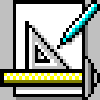


|
|

|
|||
|
|
|
To introduct the assignment, the instructor shows the class a simple cardboard I-beam made of three 10"x1" strips, and then loads it to failure. To load the beam, lay it across two tables which are 8" apart, so that 1" of the beam is on each table. Hang the bucket from the string and then slowly fill it with sand until the beam fails. Weigh the bucket/sand combination and write this failure load on the beam.
Allow the students to inspect the beam to see where it failed, and then give them four strips of cardboard each and have them construct stronger beams. Their beams may be any shape, and they may hang the bucket from the beam in any way they choose. Weigh all of the new beams and record their failure loads. If time permits, inspect these beams to see how they failed and go through a second iteration. Portions of the beam that did not deform experienced very small loads, and can be eliminated.
Students may also measure strength/weight. A solid brick of cardboard and glue will hold more weight than hollow shapes, but not enough to make up the extra "cost" in materials and weight. Have students weigh their beams (you may need a smaller, kitchen scale for this, since cardboard is very light) and find the ratio of failure load to beam weight. If a kitchen scale is not available, give a three-pound bonus for every inch of unused cardboard. Redesign for strength to weight ratio.
This is a fairly simple project to run. Ahead of time, construct one beam and collect materials. Cardboard strips for the students may have to be cut out. During class, record failure loads and strength/weight on a chalkboard or butcher paper, or, if the class is large, have the students fill out a card with their names in advance, and record the failure load and collect the card when the beam is tested. Like most in-class activities, grades based on participation only are recommended.
This project is appropriate for the following variations (most are described in the section how to make design projects more meaningful):

|
introduction | in class projects | short term projects | long term projects | related sites |

|